中考英语专题复习课件——动词精讲(分类+易错+动词短语+时态+语态+真题)
文档属性
| 名称 | 中考英语专题复习课件——动词精讲(分类+易错+动词短语+时态+语态+真题) |  | |
| 格式 | pptx | ||
| 文件大小 | 47.2MB | ||
| 资源类型 | 试卷 | ||
| 版本资源 | 通用版 | ||
| 科目 | 英语 | ||
| 更新时间 | 2025-03-18 11:34:56 | ||
图片预览

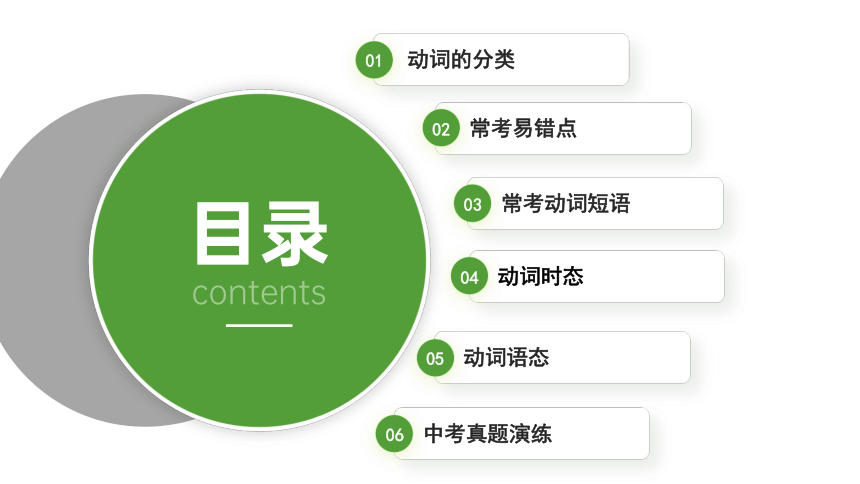

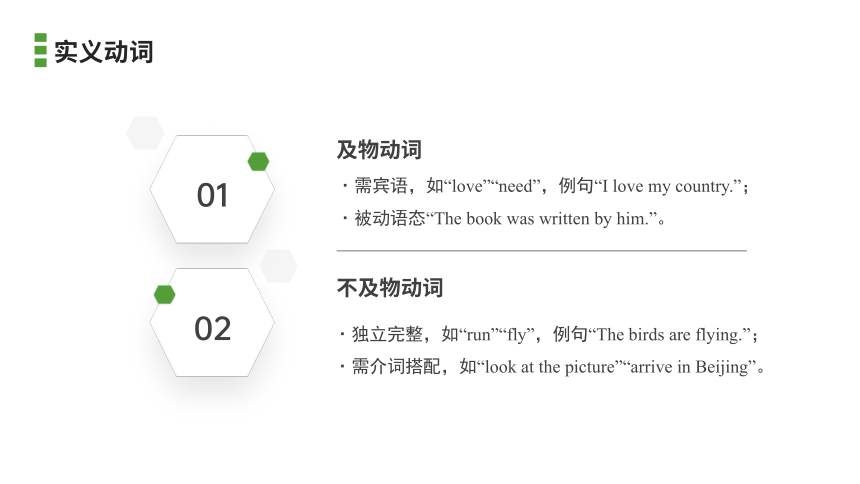
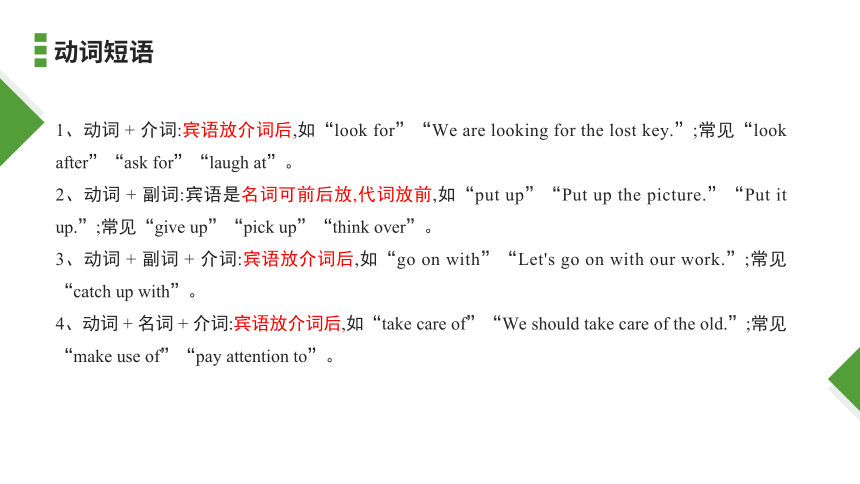
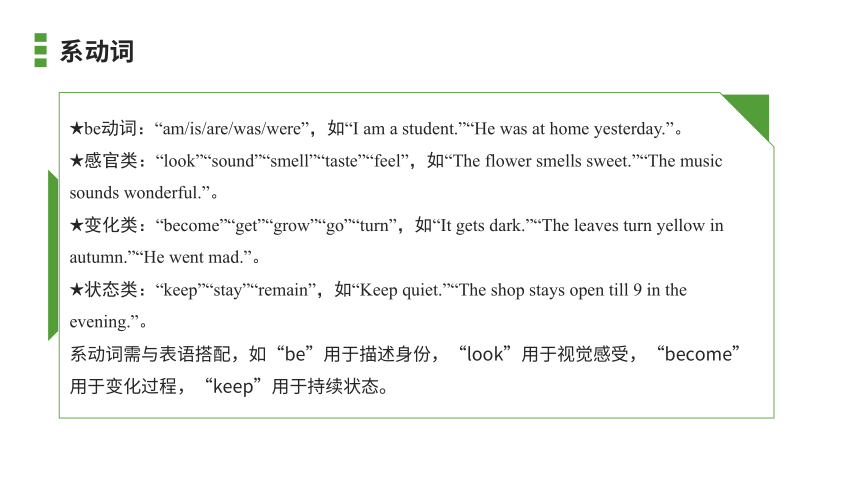
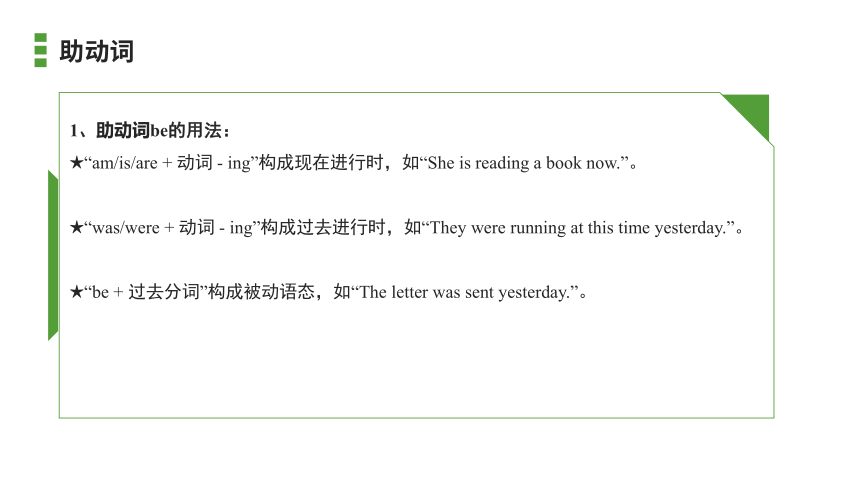
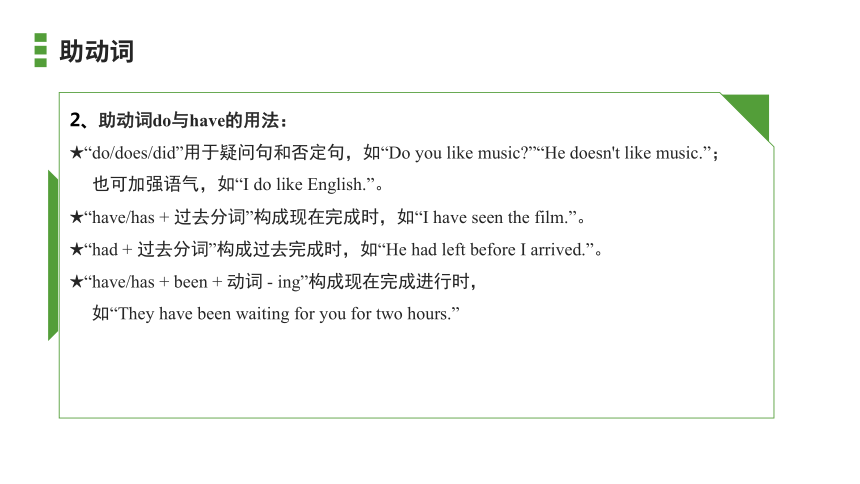
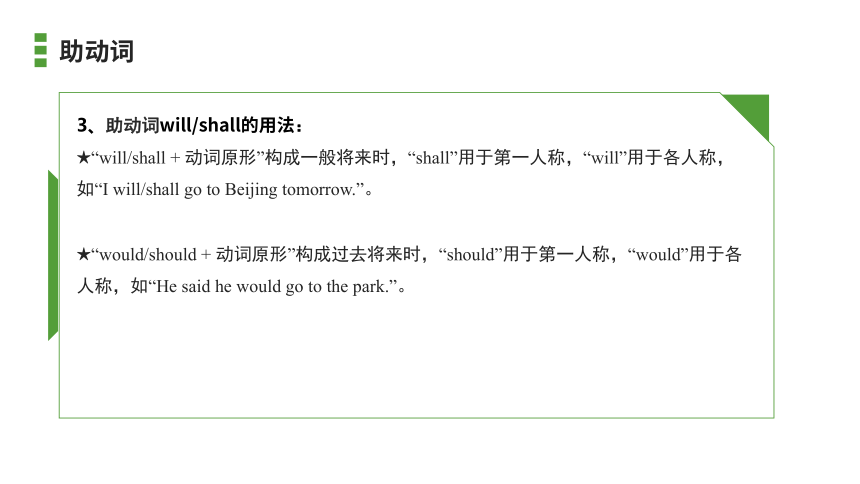
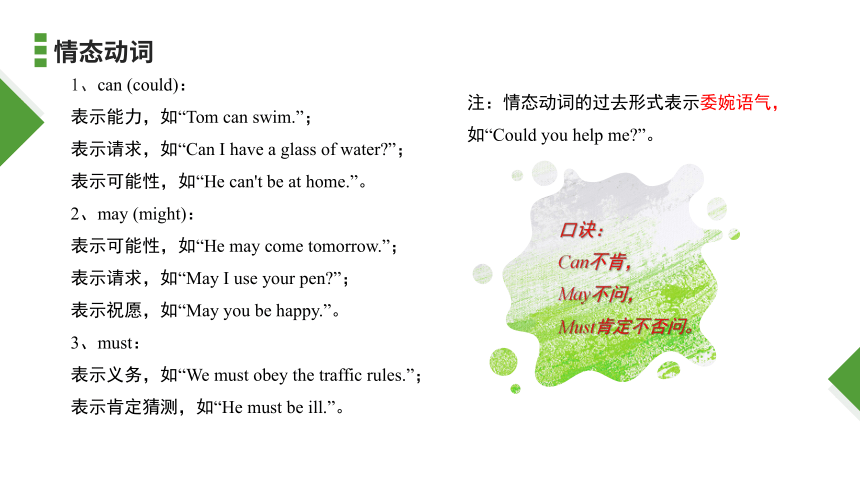
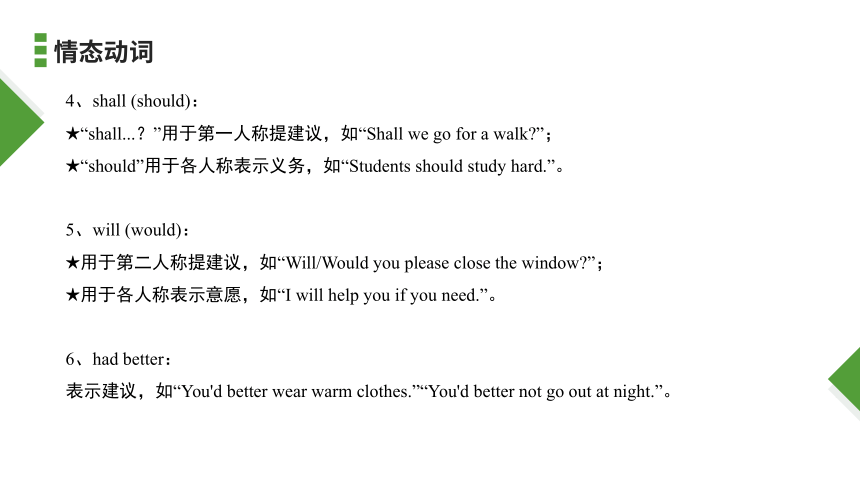

文档简介
(共52张PPT)
中考动词专题
奋力冲刺 决战中考
主讲人:张老师
时间:2025
目录
contents
动词的分类
01
常考易错点
02
常考动词短语
03
动词时态
04
中考真题演练
06
动词语态
05
PART
动词的分类
01
·需宾语,如“love”“need”,例句“I love my country.”;
·被动语态“The book was written by him.”。
·独立完整,如“run”“fly”,例句“The birds are flying.”;
·需介词搭配,如“look at the picture”“arrive in Beijing”。
及物动词
不及物动词
01
02
实义动词
1、动词 + 介词:宾语放介词后,如“look for”“We are looking for the lost key.”;常见“look after”“ask for”“laugh at”。
2、动词 + 副词:宾语是名词可前后放,代词放前,如“put up”“Put up the picture.”“Put it up.”;常见“give up”“pick up”“think over”。
3、动词 + 副词 + 介词:宾语放介词后,如“go on with”“Let's go on with our work.”;常见“catch up with”。
4、动词 + 名词 + 介词:宾语放介词后,如“take care of”“We should take care of the old.”;常见“make use of”“pay attention to”。
动词短语
★be动词:“am/is/are/was/were”,如“I am a student.”“He was at home yesterday.”。
★感官类:“look”“sound”“smell”“taste”“feel”,如“The flower smells sweet.”“The music sounds wonderful.”。
★变化类:“become”“get”“grow”“go”“turn”,如“It gets dark.”“The leaves turn yellow in autumn.”“He went mad.”。
★状态类:“keep”“stay”“remain”,如“Keep quiet.”“The shop stays open till 9 in the evening.”。
系动词需与表语搭配,如“be”用于描述身份,“look”用于视觉感受,“become”用于变化过程,“keep”用于持续状态。
系动词
1、助动词be的用法:
★“am/is/are + 动词 - ing”构成现在进行时,如“She is reading a book now.”。
★“was/were + 动词 - ing”构成过去进行时,如“They were running at this time yesterday.”。
★“be + 过去分词”构成被动语态,如“The letter was sent yesterday.”。
助动词
2、助动词do与have的用法:
★“do/does/did”用于疑问句和否定句,如“Do you like music ”“He doesn't like music.”;
也可加强语气,如“I do like English.”。
★“have/has + 过去分词”构成现在完成时,如“I have seen the film.”。
★“had + 过去分词”构成过去完成时,如“He had left before I arrived.”。
★“have/has + been + 动词 - ing”构成现在完成进行时,
如“They have been waiting for you for two hours.”
助动词
3、助动词will/shall的用法:
★“will/shall + 动词原形”构成一般将来时,“shall”用于第一人称,“will”用于各人称,
如“I will/shall go to Beijing tomorrow.”。
★“would/should + 动词原形”构成过去将来时,“should”用于第一人称,“would”用于各人称,如“He said he would go to the park.”。
助动词
1、can (could):
表示能力,如“Tom can swim.”;
表示请求,如“Can I have a glass of water ”;
表示可能性,如“He can't be at home.”。
2、may (might):
表示可能性,如“He may come tomorrow.”;
表示请求,如“May I use your pen ”;
表示祝愿,如“May you be happy.”。
3、must:
表示义务,如“We must obey the traffic rules.”;
表示肯定猜测,如“He must be ill.”。
情态动词
注:情态动词的过去形式表示委婉语气,如“Could you help me ”。
口诀:
Can不肯,
May不问,
Must肯定不否问。
4、shall (should):
★“shall...?”用于第一人称提建议,如“Shall we go for a walk ”;
★“should”用于各人称表示义务,如“Students should study hard.”。
5、will (would):
★用于第二人称提建议,如“Will/Would you please close the window ”;
★用于各人称表示意愿,如“I will help you if you need.”。
6、had better:
表示建议,如“You'd better wear warm clothes.”“You'd better not go out at night.”。
情态动词
PART
易错点
02
动词 + 副词型短语
当宾语是代词时,必须放在动词与副词之间,如“put it on”“take them away”;若宾语是名词,如“put the coat on”,两种表达皆可。
例句:“put it on”“put on the coat”“put the coat on”正确,“put on it”错误。
延续性动词与非延续性动词
延续性动词:可与时间段状语连用,如“He has lived here for ten years.”。
非延续性动词:不能与时间段状语连用,需转换为延续性动词,如“He has been away for two days.”
常见转换:“buy - have” “borrow - keep” “leave - be away (from)”
“begin/start - be on” “die - be dead”。
动词短语与代词宾语的位置
使用场景
用词搭配
感官系动词词义辨析
后接形容词作表语,而非副词,如“The food tastes delicious.”,而非“The food tastes deliciously.”。
“look”强调视觉感受,“sound”强调听觉感受,“smell”强调嗅觉感受,“taste”强调味觉感受,“feel”强调触觉感受。
情态动词答语
1. Could... 开头的疑问句,
肯定回答常用“Yes, you can.”,否定回答常用 “No, you can't.”。
例如:“Could I use your computer (我可以用你的电脑吗?)” “Yes, you can.(是的,你可以。)” “No, you can't.(不,你不可以。)” 。
2. Must... 开头的疑问句,
肯定回答用“Yes, you must.”,否定回答用 “No, you needn't.” 或 “No, you don't have to.”。
例如:“Must I finish my homework now (我必须现在完成作业吗?)” “Yes, you must.(是的,你必须。)” “No, you needn't. / No, you don't have to.(不,你不必。)”
不能用 “mustn't” 回答 “Must... ” 开头的疑问句,因为 “mustn't” 表示 “禁止,不允许”。
情态动词答语
3. May... 开头的疑问句,
肯定回答
★Yes, you may/can.:较为正式和常用,例:“May I come in ” “Yes, you may/can.”
★Yes, please do.:语气较温和、客气,带有允许和鼓励的意味。例:“May I use your pen ” “Yes, please do.”
★Sure/Of course.:比较口语化、简洁的肯定回答,例:“May I ask you a question ” “Sure/Of course.”
否定回答
★No, you may not/can't/mustn't.:may not/can't.”比较直接, mustn't”语气则更强烈,有 “禁止” 之意。
例:“May I leave now ” “No, you may not/can't/mustn't.”
★I'm afraid not.:这种回答比较委婉,通常用于不太好直接拒绝的情况。
例:“May I borrow your book ” “I'm afraid not. I'm using it now.”
★Sorry, you can't/may not.:也是比较委婉的否定回答,
例:“May I park my car here ” “Sorry, you can't/may not. It's a no - parking zone.”
情态动词答语
1、—May I take this book out of the reading room —No, you ______. You must read it here.
A. mightn't B. won't C. needn't D. mustn't
2、—______ I borrow your dictionary —Sure. Here you are.
A. May B. Must C. Need D. Should
3、You ______ drive your car so fast. It's very dangerous.
A. wouldn't B. shouldn't C. couldn't D. mightn't
答案:A
解析:根据答语 “Sure. Here you are.” 可知,问句是在请求许可,用 May I... 表示 “我可以…吗?”。
答案:D
解析:用 may 提问表示 “请求许可”,否定回答常用 mustn't,表示 “禁止,不允许”。
答案:B
解析:shouldn't 表示 “不应该”,这里是说不应该开车那么快,因为很危险,故选 B。
情态动词答语
4、—Must I finish my homework now —No, you ______. You can do it tomorrow.
A. can't B. mustn't C. needn't D. shouldn't
5、The girl in the classroom ______ be Mary. She called me from Beijing just now.
A. mustn't B. needn't C. shouldn't D. can't
答案:D
解析:can't 表示 “不可能”,根据 “She called me from Beijing just now.” 可知,在教室里的女孩不可能是玛丽。
答案:C
解析:以 Must 开头的一般疑问句,否定回答用 needn't 或 don't have to,表示 “不必”。
PART
常考动词短语
03
look短语
look at:看、注视,如“He is looking at the picture.”
look for:寻找,如“She is looking for her lost key.”
look after:照顾,如“They look after the children.”
look forward to:期待,如“They look forward to the holiday.”
look up:查阅,如“She looks up the word in the dictionary.”
get up:起床,如“He gets up early every day.”
get on/off:上车/下车,如“She gets on the bus.”
get to:到达,如“They get to the station on time.”
get along/on with:与……相处,如“They get along well with each other.”
get in:进入,如“She gets in the car.”
get短语
常考动词短语分类
put短语
put on:穿上,如“She puts on her coat.”
put up:张贴,如“They put up the notice.”
put off:推迟,如“He put off the meeting.”
put away:收起来,如“She puts away her books.”
put out:扑灭,如“The firemen put out the fire.”
take off:脱下,如“He takes off his hat.”
take away:拿走,如“She takes away the book.”
take care of:照顾,如“They take care of the children.”
take part in:参加,如“She takes part in the competition.”
take place:发生,如“The meeting takes place tomorrow.”
take短语
常考动词短语分类
give短语
give up:放弃,如“He gives up smoking.”
give away:赠送,如“She gives away her old clothes.”
give out:分发,如“The teacher gives out the papers.”
give back:归还,如“She gives back the book.”
give in:让步,如“He gives in to his friend's request.”
turn on:打开,如“She turns on the TV.”
turn off:关闭,如“She turns off the light.”
turn up:调高,如“She turns up the volume.”
turn down:调低,如“She turns down the sound.”
turn around:转身,如“She turns around to see who is calling.”
turn短语
常考动词短语分类
07
常考动词短语分类
come短语
come on:快点,如“Come on, we are late.”
come in:进来,如“She comes in the room.”
come true:实现,如“Her dream comes true.”
come up with:想出,如“She comes up with a good idea.”
come from:来自,如“She comes from China.”
go to school/work:上学/上班,如“She goes to school every day.”
go home:回家,如“She goes home after school.”
go out:出去,如“She goes out with her friends.”
go on:继续,如“She goes on with her work.”
go shopping/swimming:去购物/游泳,如“She goes shopping every weekend.”
go短语
07
常考动词短语分类
make短语
make up 组成;编造;化妆;弥补
make sure 确保;查明
make a decision 做决定
make friends with 与 交朋友
make a living 谋生
PART
动词时态
04
六大时态
一般现在时
一般将来时
过去进行时
一般过去时
现在进行时
现在完成时
1.构成:
肯定句:主语 + 动词原形(当主语为第三人称单数时,动词加 -s 或 -es)。
例如:I play basketball every day.(我每天打篮球。)He plays football after school.(他放学后踢足球。)
否定句:主语 + don't/doesn't + 动词原形。
例如:I don't like vegetables.(我不喜欢蔬菜。)He doesn't go to school by bike.(他不骑自行车上学。)
一般疑问句:Do/Does + 主语 + 动词原形?
例如:Do you like English (你喜欢英语吗?)Does he go to work by bus (他乘公交车上班吗?)
一般现在时
2.用法:
表示经常性、习惯性的动作或存在的状态。常与表示频率的时间状语连用,如 always(总是)、usually(通常)、often(经常)、sometimes(有时)、never(从不)等。例如:She usually gets up at 6:30.(她通常六点半起床。)
表示客观真理、科学事实。例如:The earth moves around the sun.(地球绕着太阳转。)
在时间状语从句和条件状语从句中,用一般现在时表示将来。例如:If it rains tomorrow, we will stay at home.(如果明天下雨,我们就待在家里。)。
一般现在时
1.构成:
肯定句:主语 + 动词的过去式。
例如:I visited my grandparents last weekend.(我上周末看望了我的祖父母。)
否定句:主语 + didn't + 动词原形。
例如:He didn't do his homework yesterday.(他昨天没做作业。)
一般疑问句:Did + 主语 + 动词原形?
例如:Did you go to the park yesterday (你昨天去公园了吗?)
一般过去时
2.用法:
表示过去某个时间发生的动作或存在的状态。常与表示过去的时间状语连用,如 yesterday(昨天)、last week(上周)、in 2023(在 2023 年)、two days ago(两天前)等。
例如:She bought a new book last month.(她上个月买了一本新书。)
表示过去经常或反复发生的动作。常与 often(经常)、always(总是)等连用。
例如:When I was a child, I often went swimming in the river.(我小时候经常在河里游泳。)
一般过去时
3.动词过去式变化规则:
一般情况下,在动词原形后直接加 -ed。如:look - looked,play - played。
以不发音的 e 结尾的动词,直接加 -d。如:live - lived,like - liked。
以辅音字母 + y 结尾的动词,变 y 为 i,再加 -ed。如:study - studied,carry - carried。
以重读闭音节结尾,且末尾只有一个辅音字母的动词,双写这个辅音字母,再加 -ed。如:stop - stopped,shop - shopped。
4.常见不规则动词过去式:
go - went,do - did,have - had,is/am - was,are - were,come - came,see - saw,make - made,take - took,get - got 等。
一般过去时
1.构成:
will/shall + 动词原形:will 可用于各种人称,shall 常用于第一人称(I/we)。
例如:I will go to school tomorrow.(我明天将去上学。)We shall have a party next week.(我们下周将举办一个派对。)
be going to + 动词原形:表示打算、计划做某事,或根据迹象推测即将发生的事。
例如:He is going to visit his friends this weekend.(他打算这个周末去看望他的朋友。)It is going to rain.(天要下雨了。)
一般将来时
2.用法:
表示将来某个时间要发生的动作或存在的状态。常与表示将来的时间状语连用,如 tomorrow(明天)、next week(下周)、next month(下个月)、next year(明年)、in the future(在未来)等。
例如:They will travel to Beijing next month.(他们下个月将去北京旅行。)
表示将来经常或反复发生的动作。
例如:I will play basketball every Sunday.(我每个星期天都将打篮球。)
一般将来时
1.构成:主语 + be(am/is/are) + 动词的现在分词(动词原形 + -ing)。
例如:I am reading a book now.(我现在正在读书。)He is playing football on the playground.(他正在操场上踢足球。)
2.用法:
表示现在正在进行的动作。常与 now(现在)、at the moment(此刻)、right now(此刻)、look(看)、listen(听)等标志性词或短语连用。
例如:She is singing a song at the concert now.(她现在正在音乐会上唱歌。)
表示现阶段正在进行的动作,但此刻不一定在进行。
例如:We are learning English this term.(我们这学期正在学英语。)
现在进行时
3.动词现在分词变化规则:
一般情况下,在动词原形后直接加 -ing。如:play - playing,read - reading。
以不发音的 e 结尾的动词,去 e 加 -ing。如:make - making,write - writing。
以重读闭音节结尾,且末尾只有一个辅音字母的动词,双写这个辅音字母,再加 -ing。如:run - running,swim - swimming。
以 ie 结尾的动词,变 ie 为 y,再加 -ing。如:die - dying,lie - lying。
现在进行时
1.构成:主语 + was/were + 动词的现在分词(动词原形 + -ing)。
例如:I was doing my homework at 8 o'clock last night.(我昨晚八点正在做作业。)
They were playing games when I came in.(我进来的时候他们正在玩游戏。)
2.用法:
表示过去某个时间点正在进行的动作。常与表示过去时间点的状语连用,如 at 7:00 yesterday(昨天七点)、at this time yesterday(昨天这个时候)、when the teacher came in(当老师进来的时候)、while I was reading(当我正在读书的时候)等。
例如:I was watching TV at 9 o'clock last night.(我昨晚九点正在看电视。)
表示过去某段时间内持续进行的动作。
例如:We were watching TV from 7 to 9 last night.(我们昨晚七点到九点一直在看电视。)
过去进行时
1.构成:主语 + have/has + 动词的过去分词。
例如:I have finished my homework.(我已经完成了我的作业。)He has been to Beijing twice.(他去过北京两次。)
2.用法:
表示过去发生的动作对现在造成的影响或结果。常与 already(已经)、yet(还,用于否定句和疑问句)、just(刚刚)、ever(曾经)、never(从未)等副词连用。
例如:I have already seen the movie, so I don't want to see it again.(我已经看过这部电影了,所以我不想再看了。)Have you ever been to Shanghai (你曾经去过上海吗?)
表示从过去开始一直持续到现在的动作或状态。常与 for + 时间段、since + 时间点或从句(从句用一般过去时)等时间状语连用。
例如:He has lived here for ten years.(他已经在这里住了十年了。)I have known him since I was a child.(我从小就认识他。)
现在完成时
3.动词过去分词变化规则:
一般情况下,动词过去分词与过去式变化规则相同。如:look - looked - looked,play - played - played。
不规则动词过去分词需特殊记忆。常见的有:go - went - gone,do - did - done,have - had - had,is/am - was - been,are - were - been,come - came - come,see - saw - seen,make - made - made,take - took - taken,get - got - got(美式英语中也常用 gotten)等。
现在完成时
PART
动词语态
05
1.主动语态:表示主语是动作的执行者。
例如:The boy kicks the ball.(这个男孩踢球。)
2.被动语态:表示主语是动作的承受者。
例如:The ball is kicked by the boy.(球被这个男孩踢了。)
01
02
主动语态
和
被动语态
两种语态
1.一般现在时的被动语态:am/is/are + 及物动词的过去分词。
例如:The classroom is cleaned every day.(教室每天都被打扫。)
2.一般过去时的被动语态:was/were + 及物动词的过去分词。
例如:The letter was written yesterday.(这封信是昨天写的。)
3.一般将来时的被动语态:will/shall be + 及物动词的过去分词;be going to be + 及物动词的过去分词。
例如:The work will be finished tomorrow.(这项工作明天将被完成。)The new building is going to be built next year.(这座新大楼明年将被建造。)
被动语态的构成
4.现在进行时的被动语态:am/is/are being + 及物动词的过去分词。
例如:The bridge is being built now.(这座桥现在正在被建造。)
5.过去进行时的被动语态:was/were being + 及物动词的过去分词。
例如:The house was being painted when I passed by.(我经过的时候房子正在被粉刷。)
6.现在完成时的被动语态:have/has been + 及物动词的过去分词。
例如:The book has been translated into many languages.(这本书已经被翻译成多种语言。)
被动语态的构成
1.不知道或没有必要指出动作的执行者时。
例如:This kind of bike is made in China.(这种自行车是中国制造的。)
2.需要强调动作的承受者时。
例如:The window was broken by Tom.(窗户是被汤姆打破的。)
3.在一些固定句型中,如 It is said that...(据说…)、It is reported that...(据报道…)等。
例如:It is said that he is a good student.(据说他是个好学生。)
被动语态的用法
1.把主动语态的宾语变为被动语态的主语。
2.把主动语态的谓语动词变为相应时态的被动语态结构。
3.把主动语态的主语放在 by 后面(如果需要指出动作执行者)。
例如:
主动语态:They clean the classroom every day.
被动语态:The classroom is cleaned by them every day.
主动语态变被动语态的方法
PART
中考真题演练
06
1.(2024 河北)—What did you do last weekend
—I ________ my grandparents in the countryside.
A. visit B. visited C. will visit D. have visited
2.(2024 河南)The students ________ an English speech contest when the teacher came in.
A. have B. had C. are having D. were having
中考真题演练
解析:last weekend 是一般过去时的标志词,句子描述的是过去发生的动作,所以用一般过去时,visit 的过去式是 visited,选 B。
解析:when 引导时间状语从句,从句用一般过去时,主句表示过去某个时间正在进行的动作,要用过去进行时)。students 是复数,be 动词用 were,have 的现在分词是 having,所以选 D。
3.(2024 四川成都)—I'm sorry I'm late.
—It doesn't matter. The meeting ________ for only 5 minutes.
A. has begun B. has been on C. began D. had begun
4.(2023 福建)—What are you doing, Tom
—I'm ________ my keys. I can't find them.
A. looking for B. looking after C. looking at D. looking through
中考真题演练
解析:for only 5 minutes 表示一段时间,谓语动词要用延续性动词。begin 是短暂性动词,be on 表示 “进行,持续”,是延续性动词短语,这里用现在完成时,结构为 have/has + 过去分词,主语 The meeting 是单数,用 has been on,选 B。
解析:look for 意为 “寻找”,强调找的动作;look after 照顾;look at 看;look through 浏览。根据 “I can't find them” 可知是在寻找钥匙,且句子用现在进行时,所以选 A。
5.(2023 呼和浩特)—When did you ________ the club —Last month.
A. join B. join in C. take part in D. attend
6.(2023 杭州)The old man ____ live in the countryside, but now he ______ living in the city.
A. used to; used to B. was used to; used to C. used to; is used to D. was used to; is used to
中考真题演练
解析:join 表示加入某个组织、团体或俱乐部等,成为其中一员;join in 指参加小规模的活动;take part in 参加群众性活动、会议等,并在其中发挥作用;attend 主要指参加会议、婚礼、上学等。根据语境,这里是加入俱乐部,且问句用一般过去时,选 A。
解析:used to do sth. 过去常常做某事;be used to doing sth. 习惯于做某事。这里表示老人过去常住在乡村,现在习惯住在城市,选 C。
7.(2024 陕西)The little boy ________ his seat to an old lady on the bus yesterday.
A. offered B. offers C. will offer D. has offered
8.(2023 山东济南)—The boy is too young to himself.
—Don't worry. He is old enough to take care of himself now.
A. wear B. put on C. dress D. have on
中考真题演练
解析:yesterday 是一般过去时的标志词,offer 的过去式是 offered,所以选 A,表示小男孩昨天在公交车上把座位让给了一位老妇人 。
解析:dress oneself 为固定搭配,意为 “给自己穿衣服”。wear 强调穿着的状态;put on 强调穿的动作;have on 同样表示穿着的状态。根据语境,男孩太小不能自己穿衣服,应选 C。
9.(2023 江苏苏州)—Can you help me the math problem It's too difficult.
—Sure. Let me try.
A. look out B. work out C. take out D. put out
10.(2024 河北)The sports meeting next week if the weather is fine.
A. will hold B. will be held C. holds D. is held
中考真题演练
解析:work out 有 “解决(问题)” 之意。look out 意为 “小心”;take out 意思是 “取出”;put out 表示 “扑灭”。根据 “math problem” 可知是解决数学问题,选 B。
解析:“next week” 表明时态为一般将来时,而 The sports meeting 和 hold 是被动关系,即运动会被举行。一般将来时的被动语态结构是 will be + 过去分词,hold 的过去分词是 held,所以选 B。
11.(2024 浙江)— you your homework yet —Yes, I it an hour ago.
A. Did; finish; finished B. Have; finished; have finished
C. Have; finished; finished D. Will; finish; finish
12.(2023 四川成都)These books by the students in our class last year.
A. read B. were read C. are read D. will be read
中考真题演练
解析:“yet” 是现在完成时的标志词,现在完成时结构为 have/has + 过去分词,所以第一空用 Have,第二空用 finished。“an hour ago” 是一般过去时的标志词,第三空用 finished,所以选 C,表示你完成作业了吗,是的,我一小时前完成的。
解析:“last year” 是一般过去时的标志词,且 These books 和 read 是被动关系,即书被读。一般过去时的被动语态结构为 was/were + 过去分词,read 的过去分词是 read,主语 These books 是复数,be 动词用 were,所以选 B,表示这些书去年被我们班学生读过。
谢谢大家
主讲人:张老师
时间:2025
奋力冲刺 决战中考
中考动词专题
奋力冲刺 决战中考
主讲人:张老师
时间:2025
目录
contents
动词的分类
01
常考易错点
02
常考动词短语
03
动词时态
04
中考真题演练
06
动词语态
05
PART
动词的分类
01
·需宾语,如“love”“need”,例句“I love my country.”;
·被动语态“The book was written by him.”。
·独立完整,如“run”“fly”,例句“The birds are flying.”;
·需介词搭配,如“look at the picture”“arrive in Beijing”。
及物动词
不及物动词
01
02
实义动词
1、动词 + 介词:宾语放介词后,如“look for”“We are looking for the lost key.”;常见“look after”“ask for”“laugh at”。
2、动词 + 副词:宾语是名词可前后放,代词放前,如“put up”“Put up the picture.”“Put it up.”;常见“give up”“pick up”“think over”。
3、动词 + 副词 + 介词:宾语放介词后,如“go on with”“Let's go on with our work.”;常见“catch up with”。
4、动词 + 名词 + 介词:宾语放介词后,如“take care of”“We should take care of the old.”;常见“make use of”“pay attention to”。
动词短语
★be动词:“am/is/are/was/were”,如“I am a student.”“He was at home yesterday.”。
★感官类:“look”“sound”“smell”“taste”“feel”,如“The flower smells sweet.”“The music sounds wonderful.”。
★变化类:“become”“get”“grow”“go”“turn”,如“It gets dark.”“The leaves turn yellow in autumn.”“He went mad.”。
★状态类:“keep”“stay”“remain”,如“Keep quiet.”“The shop stays open till 9 in the evening.”。
系动词需与表语搭配,如“be”用于描述身份,“look”用于视觉感受,“become”用于变化过程,“keep”用于持续状态。
系动词
1、助动词be的用法:
★“am/is/are + 动词 - ing”构成现在进行时,如“She is reading a book now.”。
★“was/were + 动词 - ing”构成过去进行时,如“They were running at this time yesterday.”。
★“be + 过去分词”构成被动语态,如“The letter was sent yesterday.”。
助动词
2、助动词do与have的用法:
★“do/does/did”用于疑问句和否定句,如“Do you like music ”“He doesn't like music.”;
也可加强语气,如“I do like English.”。
★“have/has + 过去分词”构成现在完成时,如“I have seen the film.”。
★“had + 过去分词”构成过去完成时,如“He had left before I arrived.”。
★“have/has + been + 动词 - ing”构成现在完成进行时,
如“They have been waiting for you for two hours.”
助动词
3、助动词will/shall的用法:
★“will/shall + 动词原形”构成一般将来时,“shall”用于第一人称,“will”用于各人称,
如“I will/shall go to Beijing tomorrow.”。
★“would/should + 动词原形”构成过去将来时,“should”用于第一人称,“would”用于各人称,如“He said he would go to the park.”。
助动词
1、can (could):
表示能力,如“Tom can swim.”;
表示请求,如“Can I have a glass of water ”;
表示可能性,如“He can't be at home.”。
2、may (might):
表示可能性,如“He may come tomorrow.”;
表示请求,如“May I use your pen ”;
表示祝愿,如“May you be happy.”。
3、must:
表示义务,如“We must obey the traffic rules.”;
表示肯定猜测,如“He must be ill.”。
情态动词
注:情态动词的过去形式表示委婉语气,如“Could you help me ”。
口诀:
Can不肯,
May不问,
Must肯定不否问。
4、shall (should):
★“shall...?”用于第一人称提建议,如“Shall we go for a walk ”;
★“should”用于各人称表示义务,如“Students should study hard.”。
5、will (would):
★用于第二人称提建议,如“Will/Would you please close the window ”;
★用于各人称表示意愿,如“I will help you if you need.”。
6、had better:
表示建议,如“You'd better wear warm clothes.”“You'd better not go out at night.”。
情态动词
PART
易错点
02
动词 + 副词型短语
当宾语是代词时,必须放在动词与副词之间,如“put it on”“take them away”;若宾语是名词,如“put the coat on”,两种表达皆可。
例句:“put it on”“put on the coat”“put the coat on”正确,“put on it”错误。
延续性动词与非延续性动词
延续性动词:可与时间段状语连用,如“He has lived here for ten years.”。
非延续性动词:不能与时间段状语连用,需转换为延续性动词,如“He has been away for two days.”
常见转换:“buy - have” “borrow - keep” “leave - be away (from)”
“begin/start - be on” “die - be dead”。
动词短语与代词宾语的位置
使用场景
用词搭配
感官系动词词义辨析
后接形容词作表语,而非副词,如“The food tastes delicious.”,而非“The food tastes deliciously.”。
“look”强调视觉感受,“sound”强调听觉感受,“smell”强调嗅觉感受,“taste”强调味觉感受,“feel”强调触觉感受。
情态动词答语
1. Could... 开头的疑问句,
肯定回答常用“Yes, you can.”,否定回答常用 “No, you can't.”。
例如:“Could I use your computer (我可以用你的电脑吗?)” “Yes, you can.(是的,你可以。)” “No, you can't.(不,你不可以。)” 。
2. Must... 开头的疑问句,
肯定回答用“Yes, you must.”,否定回答用 “No, you needn't.” 或 “No, you don't have to.”。
例如:“Must I finish my homework now (我必须现在完成作业吗?)” “Yes, you must.(是的,你必须。)” “No, you needn't. / No, you don't have to.(不,你不必。)”
不能用 “mustn't” 回答 “Must... ” 开头的疑问句,因为 “mustn't” 表示 “禁止,不允许”。
情态动词答语
3. May... 开头的疑问句,
肯定回答
★Yes, you may/can.:较为正式和常用,例:“May I come in ” “Yes, you may/can.”
★Yes, please do.:语气较温和、客气,带有允许和鼓励的意味。例:“May I use your pen ” “Yes, please do.”
★Sure/Of course.:比较口语化、简洁的肯定回答,例:“May I ask you a question ” “Sure/Of course.”
否定回答
★No, you may not/can't/mustn't.:may not/can't.”比较直接, mustn't”语气则更强烈,有 “禁止” 之意。
例:“May I leave now ” “No, you may not/can't/mustn't.”
★I'm afraid not.:这种回答比较委婉,通常用于不太好直接拒绝的情况。
例:“May I borrow your book ” “I'm afraid not. I'm using it now.”
★Sorry, you can't/may not.:也是比较委婉的否定回答,
例:“May I park my car here ” “Sorry, you can't/may not. It's a no - parking zone.”
情态动词答语
1、—May I take this book out of the reading room —No, you ______. You must read it here.
A. mightn't B. won't C. needn't D. mustn't
2、—______ I borrow your dictionary —Sure. Here you are.
A. May B. Must C. Need D. Should
3、You ______ drive your car so fast. It's very dangerous.
A. wouldn't B. shouldn't C. couldn't D. mightn't
答案:A
解析:根据答语 “Sure. Here you are.” 可知,问句是在请求许可,用 May I... 表示 “我可以…吗?”。
答案:D
解析:用 may 提问表示 “请求许可”,否定回答常用 mustn't,表示 “禁止,不允许”。
答案:B
解析:shouldn't 表示 “不应该”,这里是说不应该开车那么快,因为很危险,故选 B。
情态动词答语
4、—Must I finish my homework now —No, you ______. You can do it tomorrow.
A. can't B. mustn't C. needn't D. shouldn't
5、The girl in the classroom ______ be Mary. She called me from Beijing just now.
A. mustn't B. needn't C. shouldn't D. can't
答案:D
解析:can't 表示 “不可能”,根据 “She called me from Beijing just now.” 可知,在教室里的女孩不可能是玛丽。
答案:C
解析:以 Must 开头的一般疑问句,否定回答用 needn't 或 don't have to,表示 “不必”。
PART
常考动词短语
03
look短语
look at:看、注视,如“He is looking at the picture.”
look for:寻找,如“She is looking for her lost key.”
look after:照顾,如“They look after the children.”
look forward to:期待,如“They look forward to the holiday.”
look up:查阅,如“She looks up the word in the dictionary.”
get up:起床,如“He gets up early every day.”
get on/off:上车/下车,如“She gets on the bus.”
get to:到达,如“They get to the station on time.”
get along/on with:与……相处,如“They get along well with each other.”
get in:进入,如“She gets in the car.”
get短语
常考动词短语分类
put短语
put on:穿上,如“She puts on her coat.”
put up:张贴,如“They put up the notice.”
put off:推迟,如“He put off the meeting.”
put away:收起来,如“She puts away her books.”
put out:扑灭,如“The firemen put out the fire.”
take off:脱下,如“He takes off his hat.”
take away:拿走,如“She takes away the book.”
take care of:照顾,如“They take care of the children.”
take part in:参加,如“She takes part in the competition.”
take place:发生,如“The meeting takes place tomorrow.”
take短语
常考动词短语分类
give短语
give up:放弃,如“He gives up smoking.”
give away:赠送,如“She gives away her old clothes.”
give out:分发,如“The teacher gives out the papers.”
give back:归还,如“She gives back the book.”
give in:让步,如“He gives in to his friend's request.”
turn on:打开,如“She turns on the TV.”
turn off:关闭,如“She turns off the light.”
turn up:调高,如“She turns up the volume.”
turn down:调低,如“She turns down the sound.”
turn around:转身,如“She turns around to see who is calling.”
turn短语
常考动词短语分类
07
常考动词短语分类
come短语
come on:快点,如“Come on, we are late.”
come in:进来,如“She comes in the room.”
come true:实现,如“Her dream comes true.”
come up with:想出,如“She comes up with a good idea.”
come from:来自,如“She comes from China.”
go to school/work:上学/上班,如“She goes to school every day.”
go home:回家,如“She goes home after school.”
go out:出去,如“She goes out with her friends.”
go on:继续,如“She goes on with her work.”
go shopping/swimming:去购物/游泳,如“She goes shopping every weekend.”
go短语
07
常考动词短语分类
make短语
make up 组成;编造;化妆;弥补
make sure 确保;查明
make a decision 做决定
make friends with 与 交朋友
make a living 谋生
PART
动词时态
04
六大时态
一般现在时
一般将来时
过去进行时
一般过去时
现在进行时
现在完成时
1.构成:
肯定句:主语 + 动词原形(当主语为第三人称单数时,动词加 -s 或 -es)。
例如:I play basketball every day.(我每天打篮球。)He plays football after school.(他放学后踢足球。)
否定句:主语 + don't/doesn't + 动词原形。
例如:I don't like vegetables.(我不喜欢蔬菜。)He doesn't go to school by bike.(他不骑自行车上学。)
一般疑问句:Do/Does + 主语 + 动词原形?
例如:Do you like English (你喜欢英语吗?)Does he go to work by bus (他乘公交车上班吗?)
一般现在时
2.用法:
表示经常性、习惯性的动作或存在的状态。常与表示频率的时间状语连用,如 always(总是)、usually(通常)、often(经常)、sometimes(有时)、never(从不)等。例如:She usually gets up at 6:30.(她通常六点半起床。)
表示客观真理、科学事实。例如:The earth moves around the sun.(地球绕着太阳转。)
在时间状语从句和条件状语从句中,用一般现在时表示将来。例如:If it rains tomorrow, we will stay at home.(如果明天下雨,我们就待在家里。)。
一般现在时
1.构成:
肯定句:主语 + 动词的过去式。
例如:I visited my grandparents last weekend.(我上周末看望了我的祖父母。)
否定句:主语 + didn't + 动词原形。
例如:He didn't do his homework yesterday.(他昨天没做作业。)
一般疑问句:Did + 主语 + 动词原形?
例如:Did you go to the park yesterday (你昨天去公园了吗?)
一般过去时
2.用法:
表示过去某个时间发生的动作或存在的状态。常与表示过去的时间状语连用,如 yesterday(昨天)、last week(上周)、in 2023(在 2023 年)、two days ago(两天前)等。
例如:She bought a new book last month.(她上个月买了一本新书。)
表示过去经常或反复发生的动作。常与 often(经常)、always(总是)等连用。
例如:When I was a child, I often went swimming in the river.(我小时候经常在河里游泳。)
一般过去时
3.动词过去式变化规则:
一般情况下,在动词原形后直接加 -ed。如:look - looked,play - played。
以不发音的 e 结尾的动词,直接加 -d。如:live - lived,like - liked。
以辅音字母 + y 结尾的动词,变 y 为 i,再加 -ed。如:study - studied,carry - carried。
以重读闭音节结尾,且末尾只有一个辅音字母的动词,双写这个辅音字母,再加 -ed。如:stop - stopped,shop - shopped。
4.常见不规则动词过去式:
go - went,do - did,have - had,is/am - was,are - were,come - came,see - saw,make - made,take - took,get - got 等。
一般过去时
1.构成:
will/shall + 动词原形:will 可用于各种人称,shall 常用于第一人称(I/we)。
例如:I will go to school tomorrow.(我明天将去上学。)We shall have a party next week.(我们下周将举办一个派对。)
be going to + 动词原形:表示打算、计划做某事,或根据迹象推测即将发生的事。
例如:He is going to visit his friends this weekend.(他打算这个周末去看望他的朋友。)It is going to rain.(天要下雨了。)
一般将来时
2.用法:
表示将来某个时间要发生的动作或存在的状态。常与表示将来的时间状语连用,如 tomorrow(明天)、next week(下周)、next month(下个月)、next year(明年)、in the future(在未来)等。
例如:They will travel to Beijing next month.(他们下个月将去北京旅行。)
表示将来经常或反复发生的动作。
例如:I will play basketball every Sunday.(我每个星期天都将打篮球。)
一般将来时
1.构成:主语 + be(am/is/are) + 动词的现在分词(动词原形 + -ing)。
例如:I am reading a book now.(我现在正在读书。)He is playing football on the playground.(他正在操场上踢足球。)
2.用法:
表示现在正在进行的动作。常与 now(现在)、at the moment(此刻)、right now(此刻)、look(看)、listen(听)等标志性词或短语连用。
例如:She is singing a song at the concert now.(她现在正在音乐会上唱歌。)
表示现阶段正在进行的动作,但此刻不一定在进行。
例如:We are learning English this term.(我们这学期正在学英语。)
现在进行时
3.动词现在分词变化规则:
一般情况下,在动词原形后直接加 -ing。如:play - playing,read - reading。
以不发音的 e 结尾的动词,去 e 加 -ing。如:make - making,write - writing。
以重读闭音节结尾,且末尾只有一个辅音字母的动词,双写这个辅音字母,再加 -ing。如:run - running,swim - swimming。
以 ie 结尾的动词,变 ie 为 y,再加 -ing。如:die - dying,lie - lying。
现在进行时
1.构成:主语 + was/were + 动词的现在分词(动词原形 + -ing)。
例如:I was doing my homework at 8 o'clock last night.(我昨晚八点正在做作业。)
They were playing games when I came in.(我进来的时候他们正在玩游戏。)
2.用法:
表示过去某个时间点正在进行的动作。常与表示过去时间点的状语连用,如 at 7:00 yesterday(昨天七点)、at this time yesterday(昨天这个时候)、when the teacher came in(当老师进来的时候)、while I was reading(当我正在读书的时候)等。
例如:I was watching TV at 9 o'clock last night.(我昨晚九点正在看电视。)
表示过去某段时间内持续进行的动作。
例如:We were watching TV from 7 to 9 last night.(我们昨晚七点到九点一直在看电视。)
过去进行时
1.构成:主语 + have/has + 动词的过去分词。
例如:I have finished my homework.(我已经完成了我的作业。)He has been to Beijing twice.(他去过北京两次。)
2.用法:
表示过去发生的动作对现在造成的影响或结果。常与 already(已经)、yet(还,用于否定句和疑问句)、just(刚刚)、ever(曾经)、never(从未)等副词连用。
例如:I have already seen the movie, so I don't want to see it again.(我已经看过这部电影了,所以我不想再看了。)Have you ever been to Shanghai (你曾经去过上海吗?)
表示从过去开始一直持续到现在的动作或状态。常与 for + 时间段、since + 时间点或从句(从句用一般过去时)等时间状语连用。
例如:He has lived here for ten years.(他已经在这里住了十年了。)I have known him since I was a child.(我从小就认识他。)
现在完成时
3.动词过去分词变化规则:
一般情况下,动词过去分词与过去式变化规则相同。如:look - looked - looked,play - played - played。
不规则动词过去分词需特殊记忆。常见的有:go - went - gone,do - did - done,have - had - had,is/am - was - been,are - were - been,come - came - come,see - saw - seen,make - made - made,take - took - taken,get - got - got(美式英语中也常用 gotten)等。
现在完成时
PART
动词语态
05
1.主动语态:表示主语是动作的执行者。
例如:The boy kicks the ball.(这个男孩踢球。)
2.被动语态:表示主语是动作的承受者。
例如:The ball is kicked by the boy.(球被这个男孩踢了。)
01
02
主动语态
和
被动语态
两种语态
1.一般现在时的被动语态:am/is/are + 及物动词的过去分词。
例如:The classroom is cleaned every day.(教室每天都被打扫。)
2.一般过去时的被动语态:was/were + 及物动词的过去分词。
例如:The letter was written yesterday.(这封信是昨天写的。)
3.一般将来时的被动语态:will/shall be + 及物动词的过去分词;be going to be + 及物动词的过去分词。
例如:The work will be finished tomorrow.(这项工作明天将被完成。)The new building is going to be built next year.(这座新大楼明年将被建造。)
被动语态的构成
4.现在进行时的被动语态:am/is/are being + 及物动词的过去分词。
例如:The bridge is being built now.(这座桥现在正在被建造。)
5.过去进行时的被动语态:was/were being + 及物动词的过去分词。
例如:The house was being painted when I passed by.(我经过的时候房子正在被粉刷。)
6.现在完成时的被动语态:have/has been + 及物动词的过去分词。
例如:The book has been translated into many languages.(这本书已经被翻译成多种语言。)
被动语态的构成
1.不知道或没有必要指出动作的执行者时。
例如:This kind of bike is made in China.(这种自行车是中国制造的。)
2.需要强调动作的承受者时。
例如:The window was broken by Tom.(窗户是被汤姆打破的。)
3.在一些固定句型中,如 It is said that...(据说…)、It is reported that...(据报道…)等。
例如:It is said that he is a good student.(据说他是个好学生。)
被动语态的用法
1.把主动语态的宾语变为被动语态的主语。
2.把主动语态的谓语动词变为相应时态的被动语态结构。
3.把主动语态的主语放在 by 后面(如果需要指出动作执行者)。
例如:
主动语态:They clean the classroom every day.
被动语态:The classroom is cleaned by them every day.
主动语态变被动语态的方法
PART
中考真题演练
06
1.(2024 河北)—What did you do last weekend
—I ________ my grandparents in the countryside.
A. visit B. visited C. will visit D. have visited
2.(2024 河南)The students ________ an English speech contest when the teacher came in.
A. have B. had C. are having D. were having
中考真题演练
解析:last weekend 是一般过去时的标志词,句子描述的是过去发生的动作,所以用一般过去时,visit 的过去式是 visited,选 B。
解析:when 引导时间状语从句,从句用一般过去时,主句表示过去某个时间正在进行的动作,要用过去进行时)。students 是复数,be 动词用 were,have 的现在分词是 having,所以选 D。
3.(2024 四川成都)—I'm sorry I'm late.
—It doesn't matter. The meeting ________ for only 5 minutes.
A. has begun B. has been on C. began D. had begun
4.(2023 福建)—What are you doing, Tom
—I'm ________ my keys. I can't find them.
A. looking for B. looking after C. looking at D. looking through
中考真题演练
解析:for only 5 minutes 表示一段时间,谓语动词要用延续性动词。begin 是短暂性动词,be on 表示 “进行,持续”,是延续性动词短语,这里用现在完成时,结构为 have/has + 过去分词,主语 The meeting 是单数,用 has been on,选 B。
解析:look for 意为 “寻找”,强调找的动作;look after 照顾;look at 看;look through 浏览。根据 “I can't find them” 可知是在寻找钥匙,且句子用现在进行时,所以选 A。
5.(2023 呼和浩特)—When did you ________ the club —Last month.
A. join B. join in C. take part in D. attend
6.(2023 杭州)The old man ____ live in the countryside, but now he ______ living in the city.
A. used to; used to B. was used to; used to C. used to; is used to D. was used to; is used to
中考真题演练
解析:join 表示加入某个组织、团体或俱乐部等,成为其中一员;join in 指参加小规模的活动;take part in 参加群众性活动、会议等,并在其中发挥作用;attend 主要指参加会议、婚礼、上学等。根据语境,这里是加入俱乐部,且问句用一般过去时,选 A。
解析:used to do sth. 过去常常做某事;be used to doing sth. 习惯于做某事。这里表示老人过去常住在乡村,现在习惯住在城市,选 C。
7.(2024 陕西)The little boy ________ his seat to an old lady on the bus yesterday.
A. offered B. offers C. will offer D. has offered
8.(2023 山东济南)—The boy is too young to himself.
—Don't worry. He is old enough to take care of himself now.
A. wear B. put on C. dress D. have on
中考真题演练
解析:yesterday 是一般过去时的标志词,offer 的过去式是 offered,所以选 A,表示小男孩昨天在公交车上把座位让给了一位老妇人 。
解析:dress oneself 为固定搭配,意为 “给自己穿衣服”。wear 强调穿着的状态;put on 强调穿的动作;have on 同样表示穿着的状态。根据语境,男孩太小不能自己穿衣服,应选 C。
9.(2023 江苏苏州)—Can you help me the math problem It's too difficult.
—Sure. Let me try.
A. look out B. work out C. take out D. put out
10.(2024 河北)The sports meeting next week if the weather is fine.
A. will hold B. will be held C. holds D. is held
中考真题演练
解析:work out 有 “解决(问题)” 之意。look out 意为 “小心”;take out 意思是 “取出”;put out 表示 “扑灭”。根据 “math problem” 可知是解决数学问题,选 B。
解析:“next week” 表明时态为一般将来时,而 The sports meeting 和 hold 是被动关系,即运动会被举行。一般将来时的被动语态结构是 will be + 过去分词,hold 的过去分词是 held,所以选 B。
11.(2024 浙江)— you your homework yet —Yes, I it an hour ago.
A. Did; finish; finished B. Have; finished; have finished
C. Have; finished; finished D. Will; finish; finish
12.(2023 四川成都)These books by the students in our class last year.
A. read B. were read C. are read D. will be read
中考真题演练
解析:“yet” 是现在完成时的标志词,现在完成时结构为 have/has + 过去分词,所以第一空用 Have,第二空用 finished。“an hour ago” 是一般过去时的标志词,第三空用 finished,所以选 C,表示你完成作业了吗,是的,我一小时前完成的。
解析:“last year” 是一般过去时的标志词,且 These books 和 read 是被动关系,即书被读。一般过去时的被动语态结构为 was/were + 过去分词,read 的过去分词是 read,主语 These books 是复数,be 动词用 were,所以选 B,表示这些书去年被我们班学生读过。
谢谢大家
主讲人:张老师
时间:2025
奋力冲刺 决战中考
同课章节目录
- 词法
- 名词
- 动词和动词短语
- 动词语态
- 动词时态
- 助动词和情态动词
- 非谓语动词
- 冠词
- 代词
- 数词和量词
- 形容词副词及其比较等级
- 介词和介词短语
- 连词和感叹词
- 构词法
- 相似、相近词比较
- 句法
- 陈述句
- 一般疑问句和否定疑问句
- 特殊疑问句及选择疑问句
- 反意疑问句
- 存在句(There be句型)
- 宾语从句
- 定语从句
- 状语从句
- 主谓一致问题
- 简单句
- 并列句
- 复合句
- 主谓一致
- 主、表语从句
- 名词性从句
- 直接引语和间接引语
- 虚拟语气
- 感叹句
- 强调句
- 倒装句
- 祈使句
- 句子的成分
- 句子的分类
- 题型专区
- 单项选择部分
- 易错题
- 完形填空
- 阅读理解
- 词汇练习
- 听说训练
- 句型转换
- 补全对话
- 短文改错
- 翻译
- 书面表达
- 任务型阅读
- 语法填空
- 其他资料
